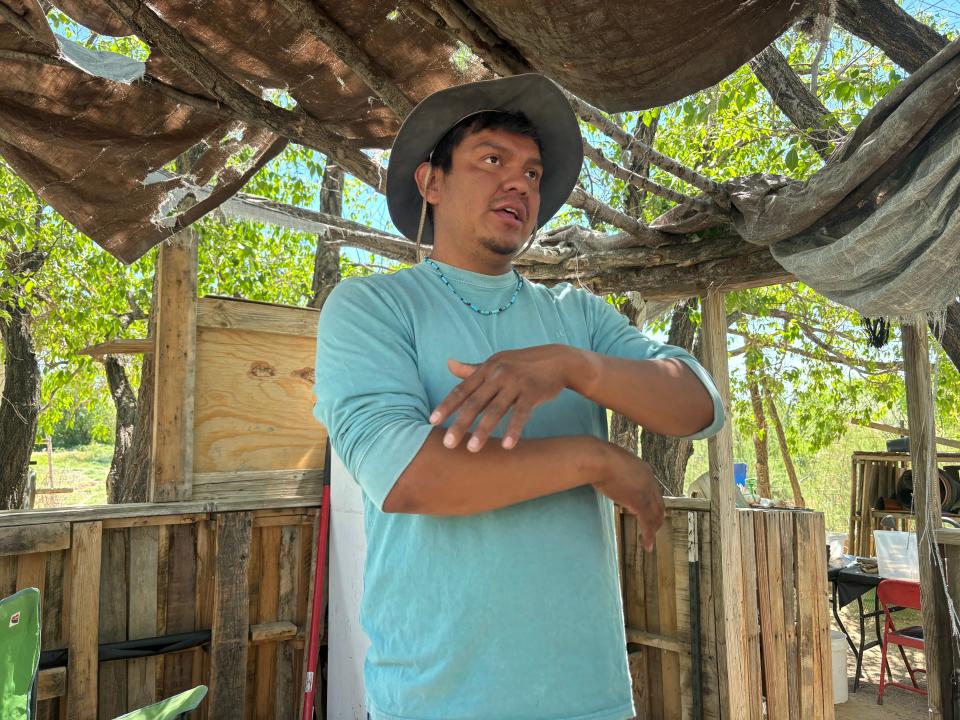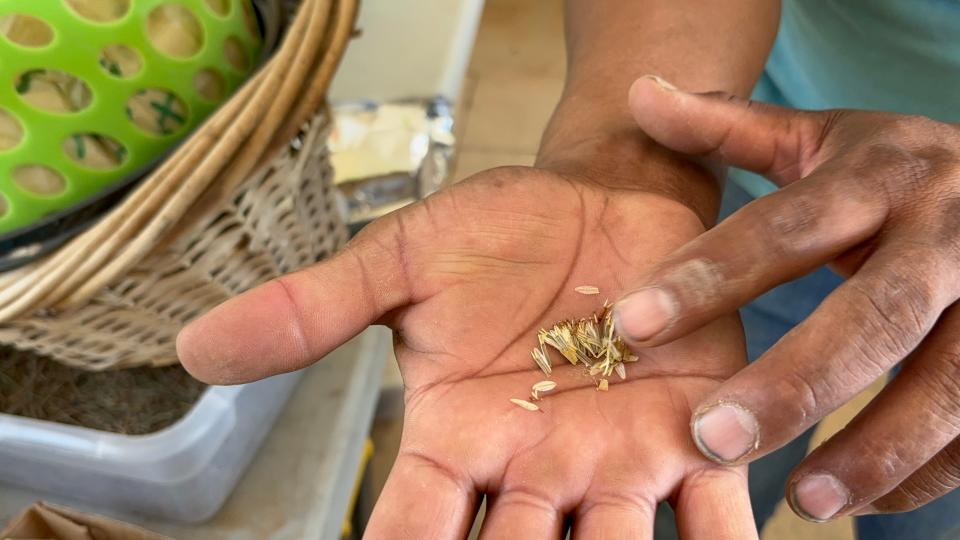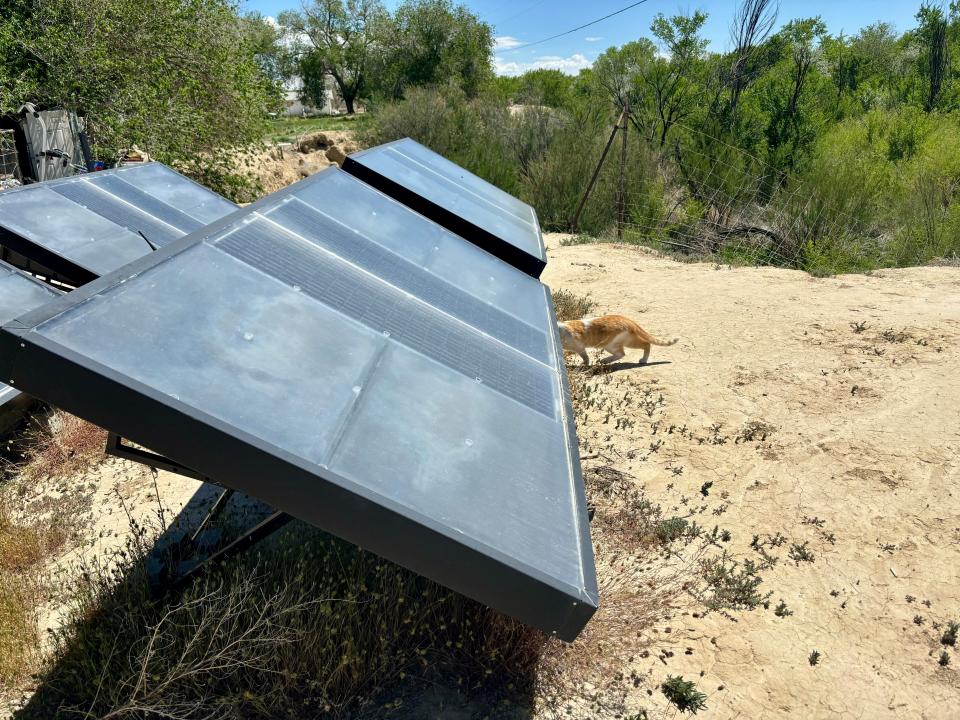Planting seeds: How this Navajo farmer hopes to bring food and water security to others
SHIPROCK, N.M. — Graham Biyáál lives on Farm Road in the Navajo community of Shiprock, on a roadway, fittingly named, that leads to many of the area's farms.
In 2020, the road also became notorious for the illegal hemp and marijuana farms spearheaded by Dineh Benally, whose operations were raided and shut down amid allegations that the workers were hired under false pretense and forced to log long hours.
That same year, as the pandemic forced people into lockdown and the Navajo Nation faced severe restrictions, Biyáál moved into a tent on his mother’s farmland to pursue his farming aspirations. He lived there for two and a half years.
“I broke myself away from society,” said Biyáál, who's now 34. He describes the time as a challenging and "nihilistic period" in his life. “I remember thinking how do we get ourselves into fighting for toilet paper? There was a point where I said ‘nope, I’m done. There has to be a better way to take care of ourselves.’”
When he decided to settle on the 3- or 4-acre plot, he recalled thinking that all he needed was to secure water and food for himself. That sparked a broader vision of food sovereignty, and how both his community and the rest of the Navajo Nation could achieve food and water security, a vision that would ultimately influence what he is doing now.
At one point Biyáál worked for a nearby charter school and saw how kids came to school just to eat a balanced meal, while dinners at home would be fast food.
“You have little six- or seven-year-olds who are hungry, and kind of worried about food,” said Biyáál. “If you can eliminate that, find a way to make it so we are not worried where our food is coming from or worried about our water, imagine the possibilities when it comes to community.”
Biyáál has ambitious plans for the section of family farmland that his parents were reluctant to manage. The plot, near a wash, has partially eroded, leaving only 2.5 acres suitable for planting. The land was also infested with prairie dogs and their burrows, which he referred to as a "prairie dog metropolis," but Biyáál has successfully tackled these challenges to pursue his farming vision.
“The goal of this place is to turn it into a permaculture homestead,” said Biyáál, “where I'm essentially a food forest. A place where I am not having to worry about plowing, planting every year, tilling. The land just provides for me.”
No longer living in a tent, Biyáál now resides in a small but expanding cabin he built. Because of Navajo Nation red tape, Biyáál admits that living on farmland is not allowed today, which was never the case for his great-grandparents, grandparents and even his parents.

Biyáál said if Dineh Benally could establish a large illegal hemp and marijuana farm, create chaos within the community, and face minimal consequences — even allowed to run for Navajo Nation president in 2022 — he should certainly be allowed to live on and cultivate the farm his great-grandparents set aside for him.
"My parents' generation was even able to do what they want," he said. "They could put a trailer on, build a house, they could do what they want. But for me, I am literally squatting here. In 2007, they passed, I'm not sure who passed it, but designated farm land is not allowed to be converted to homesite lease. A majority of Shiprock is farmland. The bureaucracy that goes with it, you see it in the young generation, it's so hard to secure land."
So, how does Biyáál manage? Lacking electricity, he uses solar panels he brought back from his time at Standing Rock, S.D. Outside his cabin, he has set up workout equipment for personal use and to train others, as well as an outdoor kitchen under a shaded structure.
Inside a non-functional mini refrigerator, trays of seeds in little sandwich bags are stored for germination before being transferred to planters. The seeds include sumac (chiiłchin), yucca, peaches and others.
He has what he calls a seed station a few feet away from his kitchen area, and inside another full-sized refrigerator, he stocks a variety of valuable heirloom seeds that come from his grandparents and great-grandparents, as well as seeds from Seed Savers Exchange, which stewards America’s culturally diverse and endangered garden and food crop legacy for present and future generations. They gave Biyáál seeds they collected from Navajo in the 1980s and 1990s.
“My main focus is building a seed bank,” said Biyáál. “I’m also learning how to make my own potting soil. Two things I want to be able to have are a soil lab and a water lab, trying to figure out the content of the soil.”
Farming: 'It's all about their roots'
Biyáál comes from a family of farmers — his late great-grandmother was a well-known herbalist — so his aspirations came as no surprise to his parents, who live down another lane from this plot of land.
“A lot of people always, even myself, have that question of what is traditional farming,” said Biyáál, who said he started farming on his own when the pandemic hit. “How did we farm back in the day? It just mattered where you lived, even on the rez, you either lived by the river, the mountain or by really dry areas.”
Traditional methods of planting are also used for ceremonial purposes, he said, including four different types of cornfields, one of which is a spiral field. He is establishing two of these, planning to plant Navajo tea in the larger field.
“They are very sensitive, Navajo Tea,” explained Biyáál. “They’ll sprout pretty easily but they’ll die. They have to have a good period of establishing their roots. They’ll be small but will be establishing their roots, and that’s the whole thing about perennials. It’s all about their roots.”
With the famous Shiprock pinnacle visible from his farm, Biyáál humorously described himself as a “bad Navajo” because he is allergic to corn. Yet the first thing he planted on his farm was blue corn.
Walking through the land, Biyáál points to where he transplanted a juniper tree. He envisions planting trees all along a bluff nearby to strengthen the soil to stop the erosion.

He is also attempting to grow grapes and envisions a future where families can come by and pick grapes from his vineyard.
“The goal is to have rows of Navajo tea and the grapes on top of that, so they would work together,” said Biyáál. “Again, it’s a permaculture thing that I don’t need to plant them every year and they just come out. It will also be a space where families can just come out and pick their grapes.”
Last month, Biyáál and 20 other Shiprock farmers between the ages of 13 and72, who are part of the non-profit Toohnii Binaneest'ą' Ałtaas'éí Alliance, traveled to Washington, D.C. to advocate for for the Farm Bill, a massive piece of legislation covering farm programs, conservation, rural development, forestry, trade promotion, nutrition, and even ag research and education. The group was sponsored by Native Farm Bill Coalition.
He emphasizes the importance of using farming as a tool to combat what he calls "predigested food," arguing that much of what is considered food today isn't truly food and contributes to many illnesses such as diabetes, high blood pressure and heart disease.
American Indians and Alaska Natives have a greater chance of having diabetes than any other US racial group, according to the Centers for Disease Control. A 2023 study by UCI Program in Public Health observed that Type 1 diabetes was 1.5 times more prevalent among American Indian and Alaska Native children under 10 years old compared to Type 2 diabetes, but starting from age 10, the prevalence of Type 2 diabetes surpassed that of Type 1 diabetes.
Research suggest that socioeconomic status, behavioral influences, environmental conditions, nutrition, and access to health care, are the factors for this surge.
"We are still a collective, despite our differences and how polarized we can be. In the way we Diné move together through all these worlds, wars, genocides, everything, we are still together," said Biyáál. We still have that fundamental knowledge and way of thinking, and that brings us to where we are at in the fight against diabetes."
Biyáál believes it is up to Indigenous people to restore balance when it comes to food, reflecting on the 1863 U.S. government's scorched-earth campaign against the Navajo to starve them into submission, then relocate them to Bosque Redondo in what is known as the Long Walk.
"I feel we as Diné people are at the forefront of ultra processed foods because of what it is doing to our people," said Biyáál. "We are still trying to come back from the scorched earth campaign. If you control the food, you control the people."

Water: Finding security for a critical resource
Biyáál is also working to better secure water supplies for farmers around Shiprock. He is motivated by the August 2015 Gold King Mine spill, a disaster he said "traumatized" him.
The spill occurred when the U.S. Environmental Protection Agency and its contractors triggered a "blowout" at the mine, near Silverton, Colo., where work was underway to clean up after years of mining.
The blowout released at least 3 million gallons of toxic acid mine wastewater into Cement Creek, a tributary of the Animas River which flows into the San Juan River and through the Navajo Nation.
At least 880,000 pounds of heavy metals poured out and coursed through downstream waterways, including approximately 200 miles of the San Juan River, which flows west through Shiprock.
“The Gold King Mine Spill, it really opened my eyes that we always need to test our water,” said Biyáál. “Maybe not rely on the government to do that for us but to have our own. It was one of the most traumatizing events I’ve ever gone through.”
He recalled seeing everyone’s fields in the area die, with nothing to be done to prevent it.
“The general farming age in Shiprock is over 60 and so a lot of people needed help,” said Biyáál. “Because the water is off, and everyone is in full swing of planting and everything died.”
This unsettling period left an indelible mark on Biyáál, driving him to search for ways to ensure water security. He is exploring four approaches to building water sovereignty and security.
"One is a hydro solar panel that collects water from the air,” listed Biyáál. “The second one would be irrigation. Third one is, I would like to build myself a well, and the last one would be rain catchment.”
Using a grant he received through John Hopkins University, Biyáál purchased hydropanels from a Tempe-based company called Source. A hydropanel is like a solar panel, but instead of creating energy, it creates clean, safe drinking water without electric hookups or infrastructure, nearly anywhere, according to the company’s website.
“It generates maybe about two quarts of water a day,” said Biyáál. Recently he was able to set up a 550-gallon tank to hold the water, and he now plans to build a pump shed so he can pump water to his cabin and an office trailer that sits on the land.
Navajo Nation crop insurance offers aid
To support Navajo farms and rangeland, the Navajo Nation Council voted recently to extend the Síhasin Fund reserve of over $10.9 million for the annual premium of the crop insurance program, administered by the Navajo Nation Department of Agriculture.
In 2016, the Navajo Nation participated in the U.S. Department of Agriculture Rainfall Index Pasture, Rangeland, and Forage pilot insurance program. Crop insurance is designed to provide coverage on pasture, rangeland and forage acres and is based on a rainfall index that determines precipitation within an area.
“We know this crop insurance is a very critical resource that supports our ranchers and farmers in years of drought conditions,” said legislation sponsor and Resources and Development Committee Chair Brenda Jesus. “The continued uncertainty of climate change impacted the Navajo Nation and its producers and farmers during the summer months.”
According to the Department of Agriculture, the Navajo Nation has received over $110 million through the program since 2016. In February, a $13.5 million crop insurance check was sent to the Navajo Nation for indemnities based on the 2023 crop year.
“These projects improve the range, tribal ranches, and support ranching and growing practices,” wrote President Buu Nygren when signing the extension resolution. “Almost 10 years later, the Navajo Nation sees the benefit of participating in this program.”
Biyáál had never heard of the program and said information about such programs from the council is not readily accessible to the actual Navajo farmers.
For now, food and water security are top priorities for Biyáál. Community is also important to him, and he aims to strengthen it through his farm. He plans to create a space where people can camp and set up volleyball nets, and hold farmers markets. He plans to convert part of a donated trailer, currently used as his office and silversmithing workspace, into a food stand where visitors can select produce from his farm and have it prepared on the spot.
"I'm trying to generate more community events within Shiprock," said Biyáál.
Biyáál has a website biyaaltradingpost.com where he sells products from his farm such as Navajo Tea, Blue Mush Kit, and various types of seeds from corn to melons.
Arlyssa D. Becenti covers Indigenous affairs for The Arizona Republic and azcentral.com. Send ideas and tips to arlyssa.becenti@arizonarepublic.com.
Support local journalism. Subscribe to azcentral.com today.
This article originally appeared on Arizona Republic: How one Navajo farmer hopes to bring food and water security home

